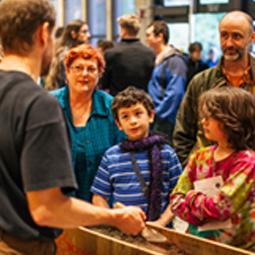[Chief Dr. Janice George]
The weaver’s spirit to me is the generosity of the ancestors. Something that was left to us. Something that we're, gathering back, gathering back, gathering back.
All of this spirit, all the feelings that the weavers had to share with the community.
[Gail White Eagle]
Our ancestors started this way back in the beginning of time. So, they've been doing this since, you know, grandmother Cedar tree taught em’, since spider taught em’, you know. Really since the time of [Lushootseed]. It's been here. It's been a part of this land. It's been a part of our DNA forever.
[Chief Dr. Janice George]
I just love sharing the tenacity and resilience and strength that those ancestors who came through that keyhole carrying our gifts of weaving, carving, canoe building, medicine making — all of it. How grateful and how much I admire that.
[Willard "Buddy' Joseph]
You know, back in the day to produce a blanket, it meant the whole community was working together.
[Kelly Sullivan]
The pride that a piece, a finished piece brings to the group of people that contributed. All of our spirits are connected in that, all of that, every step of the way. The weaving has a spirit energy in every piece. Those alder cones, those mushrooms, the fiber that we gathered that's what gives the weaving so much power.
And it definitely helps us all feel unified. It helps us feel loved.
[Tillie Jones]
It keeps us all together, right? We all need each other.
[Willard "Buddy" Joseph]
When my mom told me years ago when I was a child that it had monetary value, I couldn't get it. But now that I know the history, the history of it, and just to think that our people gave away hundreds of these pieces, you know, to try and weave something is just puts more context to understanding the why was so valuable to us in more ways than one.
You know, this is something somebody had to sit down and figure out how to do these things, somebody had to sit there and look at mountain goat wool and, and, you know, it's like, darn, I could spin this, you know, I could make some clothing out of this. Like, that's what I marveled at. This was something that's been here for thousands of years.
[Gail White Eagle]
It's our connection, our connection to our ancestors. We're recognizing and honoring the fact that, you know, they spent all that time and all that energy, gathering, weaving, spinning, dyeing to make their garments. And we're working hard and we're working diligently to learn from those garments, to bring them back so that our people can be proud. And feel honorable again to wear them, to give them away, to have ceremony in them.
Yes, we are trying to heal ourselves. They're weaving, trying to pick our people up and help stand them up through this weaving process.
[Tillie Jones]
People that were our teachers and now they're our ancestors. And that'll be us someday.
[Chief Dr. Janice George]
And I want to pass that feeling on. I want people to understand that their ancestors worked to have them here, no matter who it is, no matter who it is. I know how fortunate I am to have this and what our ancestors worked for. How lucky and how, privileged I feel to, you know, feel that love from them. Know that they were looking out for me. But everybody can have that.
[Gail White Eagle]
It's just the connection and the energy of it all. The spiritual energy, the love.
[Tillie Jones]
We know now that it will continue. There's not a doubt in my mind that our Coast Salish, way of life will continue.
